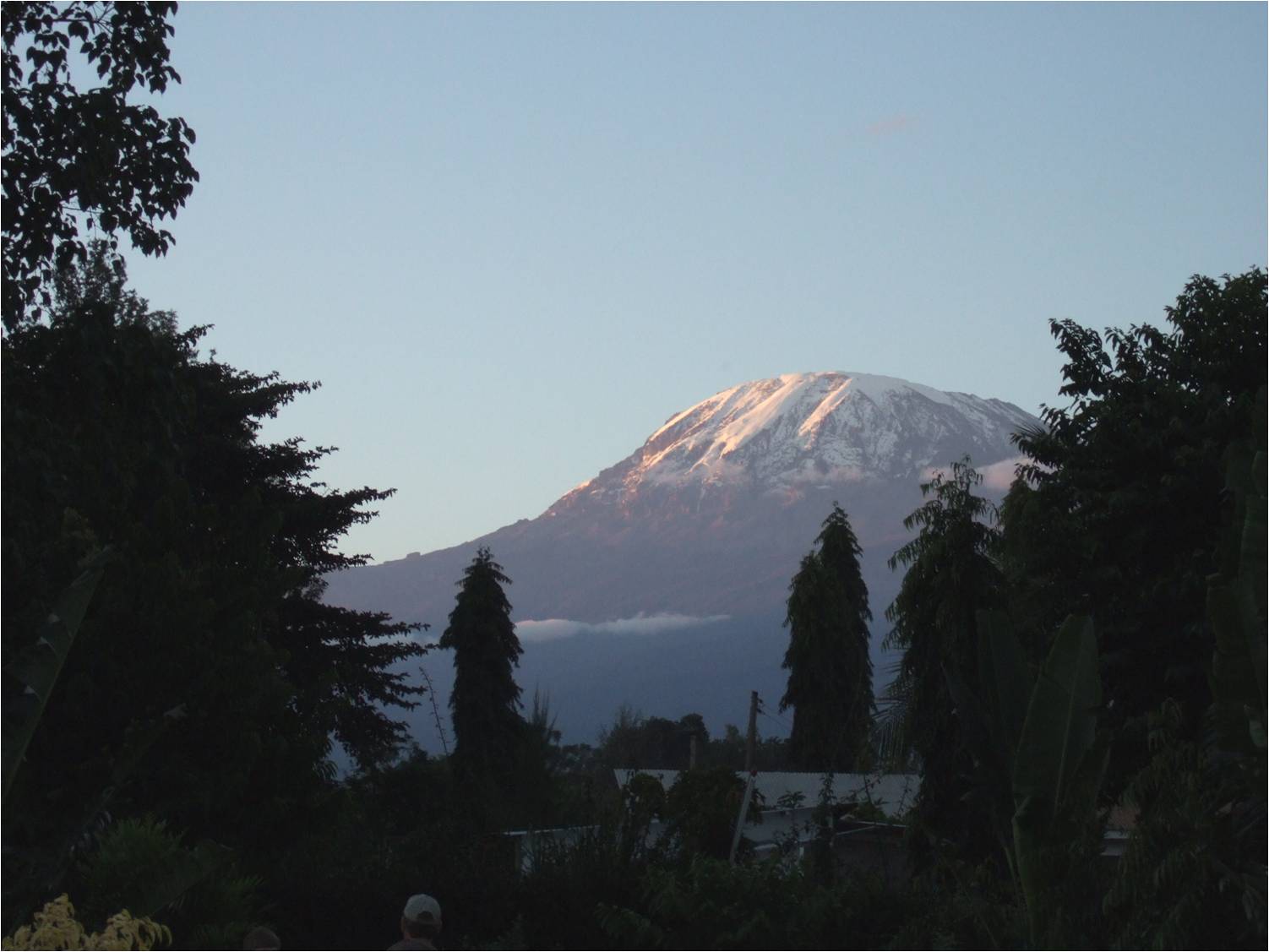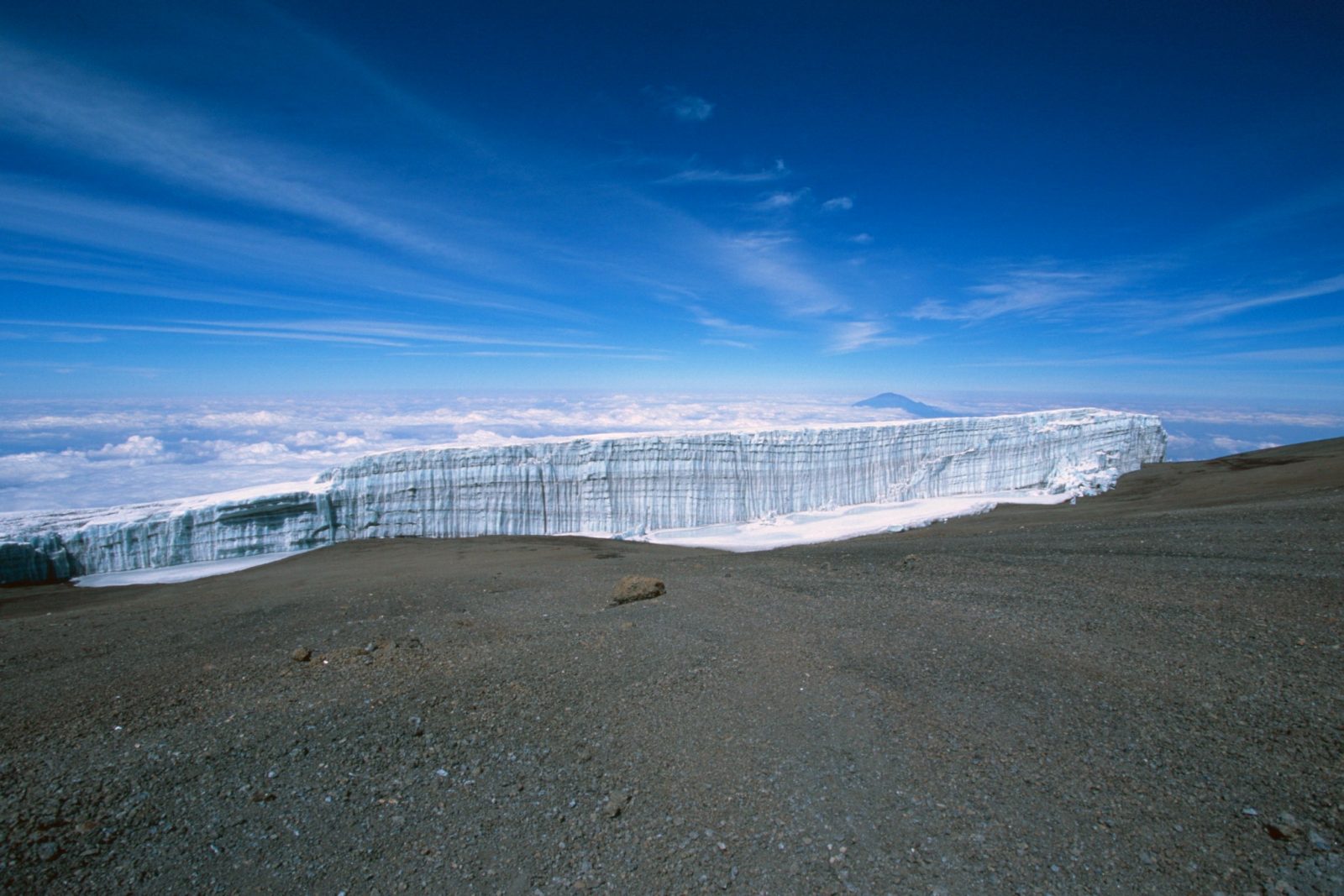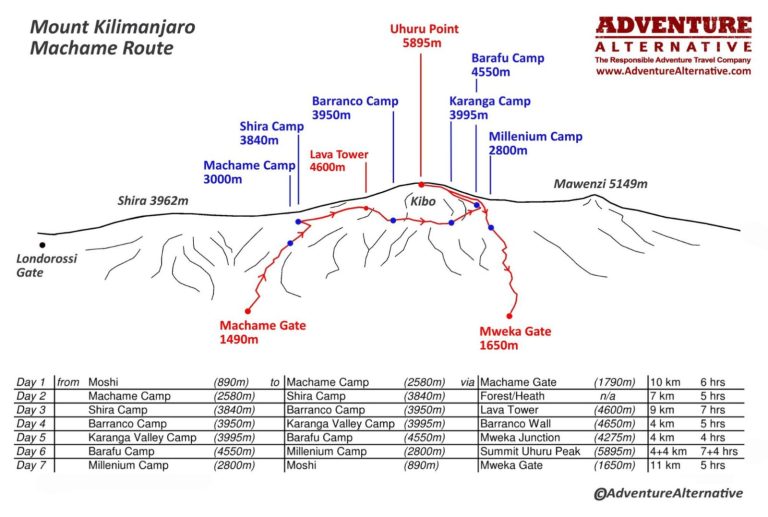
Climb Kilimanjaro Machame Route
The Machame route on Kilimanjaro is a seven day camping route which allows for excellent acclimatisation and showcases the diverse habitats particularly well, from the belt of tropical rainforest to alpine meadow and moorland, and the moonscape of rock in the high desert to the snow and ice of the glaciated summit. It has been called the Whiskey route in the past and nowadays about 40% of all climbers on the mountain use it, as each day presents quite a distinct ecosystem to experience.
Overview
The Machame route on Kilimanjaro is a seven day camping route which allows for excellent acclimatisation and particularly diverse scenery. It has been called the Whiskey route in the past and nowadays about 35% of all climbers on the mountain use it.
In a matter of days you will climb Kilimanjaro from the equator up to an Arctic zone, moving through grasslands, tropical rainforest, alpine meadows, moorlands and high desert to snow and ice. Each day on this route presents quite a distinct ecosystem to experience, which is one reason it is so popular.
The other reason is that the seven day programme begins on the south west side of the mountain and traverses around to the south east side, enabling you to sleep at the same altitude for three consecutive nights which significantly aids altitude acclimatisation. This means that our summit success rate on this route is quite high at around 85%.
We only run seven day trips on Kilimanjaro which is the recommended minimum number of days by all the international mountain associations such as the UIAA (International Climbing and Mountaineering Federation), plus our own assessment of mountain safety. The Machame route could be done in six days by missing out Karanga Valley and going straight to Barafu, but experience tells us that this leads to increased sickness and a much lower summit success rate.
From the start you will be speaking with experienced people who have climbed Kilimanjaro many times, including Gavin Bate who has been leading groups on the mountain regularly since 1994 and is always on hand for advice. We can give you an honest appraisal of the climb, about training for the mountain and what clothing and equipment you will need to buy or rent. This personal service extends to our staff iin Tanzania where AA Tanzania co-ordinator Castro Kapela will meet you and give a team briefing along with our guides.
What Our Adventurers Think:
We started out with a charity climb of Mt Kilimanjaro for Alzheimer’s Australia NSW. There was a group of 18 people to start ranging from early 20s to 64!
Then 5 of us moved onto a post climb safari in Ngorogoro, Lake Manyara and Tarangire which AA head office set up for us. It was nice having the same operator covering both so they knew the drill and made the transition out of Moshi so simple.
We did our own thing for a couple of weeks then met up with another AA team in Kenya for a Masai Mara safari with just my husband and I.
Adventure Alternative from the main office were only too willing to give oodles of guidance and answer an array of silly questions over the past 6 months. On everything from altitude advice to which camera lenses to pack, they answered everything.
The crew on Kili were great. Because of my injury I could go up ok but down was a nightmare. I couldn’t get down quickly enough and the mountain crept in. My body just wanted to shut down and sleep but Kamanda wouldn’t have a bar of it. I was pretty convincing I thought, “just 5 minutes sleep and I’ll be good to go again” I pleaded, but he kept me going with very calm but strict orders. He even gave me his sandals for the trip down when my feet couldn’t fit in my boots anymore. Pete and I also had a really great experience with a porter named Manus. If you’re looking for an up and comer, he was great, personable, eager to help, always on the front foot…
The safari in the crater etc was good. I think we found the setup of the Kenyan one a little better though with separate guide and driver to help with alertness on the long drives.
I was originally so sad that I wouldn’t have time to visit Moving Mountains to learn and see more about the charity arm, but having Kelly in the car with us was perfect. Pete and I got to ask all the questions we wanted and learn all about what Moving Mountains does there. We talked the whole trip to the Mara. We also found him very knowledgable about all things Kenya. We quizzed him on politics, logistics, religion… You name it, and he had good solid conversation on each of them. We were really impressed.
Kamau, the driver, was also awesome. He tried so hard to find things for us and was super chilled with a sly sense of humour. He was gutted he didn’t spot is a leopard but seriously tried harder than any other safari driver I’ve ever had. There were a couple of technical problems but they acted like total pros in how they dealt with the obstacles and were even sorting things out at 3am to make sure we had as minimal impact as possible. They really did a good job, I’d go with them again in a heartbeat.
Machame Route Day By Day Programme
We’ve outlined the itinerary of our 7-day Machame Route trek, which covers a distance of 64 kilometres and reaches an altitude of 5895m.
Arrive into Tanzania. Most people fly into Kilimanjaro airport either directly or via Kenya. Overnight in Keys Annexe Hotel in Moshi Town
Spend the day in Moshi. Meet the AA Tanzania staff and have time for hiring equipment or relaxing in the hotel. This is a good day to hydrate fully for the start the next day.
Transport to Machame Gate (1 hour up to 1790m). Registration (sometimes it can take a few hours or so for this process). Trek to Machame Camp through beautiful montane forest on good path. Camp overnight at the edge of the forest.
Machame Camp to Shira Plateau uphill through thinning forest and onto a huge volcanic plateau. Camping is more exposed here with great views of the summit massif.
Shira Camp to Barranco Camp traversing two valleys skirting the base of the summit massif. High desert environment with amazing rock formations, quite exposed to the weather, dropping into the Barranco Valley right beneath the Western Breach. This day ascends a maximum of 700 metres but the net height gain is only about 100 metres.
Barranco Camp to Karanga Valley, starting with a scramble over the Barranco Wall and over a further two valleys to get to this open campsite with great views of the Heim Glacier. Another up and down day but no net gain in height, which is all good for acclimatisation.
Karanga Valley to Barafu Camp, heading upwards towards the open rock and colder temperatures. Barafu means ‘ice’ in Swahili and the camping is amongst the rocks. Early dinner.
Summit day. Night-time ascent on rock and scree, snow and ice, to the crater rim and the summit. Expect cold temperatures with windchill. The final slope to the crater rim and Stella Point has loose scree and is very slow. From Stella Point it is a further 45 minutes up the escarpment to the summit of Uhuru.
Descend in sunlight to Barafu for early lunch, and then walk down to Millennium Camp, normally arriving mid-afternoon.
Millennium to Mweka Gate. Descend through the lush forest to Mweka Gate where you sign out and pick up the summit certificate. Legs will be tired! Meet Castro at the gate for transport back to the hotel, arriving normally at about 2pm.
The gate is where tips are handed out and you say goodbye to the mountain staff, although sometimes this is done at the hotel. A hot shower and an afternoon relaxing.
Either start the safari or depart home.
Ready for an Adventure on Kilimanjaro?
Choose a scheduled date or contact us to set up private dates or a bespoke itinerary. The minimum deposit is £200.00 and the balance is due four weeks before travel.
Fixed Itineraries
| Start Date | End Date | Days | Price (per person) | |
|---|---|---|---|---|
| 05/07/2025 | 14/07/2025 | 10 | £2,045.00 | Book Now |
| 19/07/2025 | 28/07/2025 | 10 | £2,045.00 | Book Now |
| 02/08/2025 | 11/08/2025 | 10 | £2,045.00 | Book Now |
| 16/08/2025 | 25/08/2025 | 10 | £2,045.00 | Book Now |
| 13/09/2025 | 22/09/2025 | 10 | £2,045.00 | Book Now |
| 04/10/2025 | 13/10/2025 | 10 | £2,045.00 | Book Now |
| 06/12/2025 | 15/12/2025 | 10 | £2,045.00 | Book Now |
| 25/12/2025 | 03/01/2026 | 10 | £2,045.00 | Book Now |
| 10/01/2026 | 19/01/2026 | 10 | £2,045.00 | Book Now |
| 07/02/2026 | 16/02/2026 | 10 | £2,045.00 | Book Now |
| 21/02/2026 | 02/03/2026 | 10 | £2,045.00 | Book Now |
| 21/03/2026 | 30/03/2026 | 10 | £2,045.00 | Book Now |
| 23/05/2026 | 01/06/2026 | 10 | £2,045.00 | Book Now |
| 06/06/2026 | 15/06/2026 | 10 | £2,045.00 | Book Now |
| 04/07/2026 | 13/07/2026 | 10 | £2,045.00 | Book Now |
| 18/07/2026 | 27/07/2026 | 10 | £2,045.00 | Book Now |
| 01/08/2026 | 10/08/2026 | 10 | £2,045.00 | Book Now |
| 15/08/2026 | 24/08/2026 | 10 | £2,045.00 | Book Now |
| 12/09/2026 | 21/09/2026 | 10 | £2,045.00 | Book Now |
| 03/10/2026 | 12/10/2026 | 10 | £2,045.00 | Book Now |
| 05/12/2026 | 14/12/2026 | 10 | £2,045.00 | Book Now |
| 25/12/2026 | 03/01/2027 | 10 | £2,045.00 | Book Now |
Private Itineraries
Our Machame Route Kilimanjaro Experts
Castro has been the Director of AA Tanzania for twenty years now and is well known and respected in Moshi. From Zulu descent, his infectious laugh and calm manner has been a big help to many hundreds of our clients over the years. He also understands the company ethos of looking after the staff well and is a popular employer in the town. With our support he is able to pay excellent salaries, provide training in first aid and altitude, and ensure that everyone is happy in their...
Kilimanjaro Machame Land Only Cost From £2045.00
7 day trek plus arrival day, rest day and departure day, total of 10 days. Many people add a safari after Kilimanjaro or stay on to visit Zanzibar or other destinations.
INCLUDES
- Accommodation in Moshi for 3 nights in the Keys Annexe Hotel (twin, B&B)
- Transport to the mountain gate from and to Moshi
- Park fees, camping fees and park rescue fees
- Park certified guides (ratio of 1:2 or 1:3 depending on team size) who are outdoor first aid qualified
- Porters and cooks, plus equipment and tents for them
- All camping equipment including sleeping tents with mattresses
- Trip administrator
- Meals on the mountain – fresh food, 3 meals per day
- Oxygen bottles and masks, mountain shelter and portable stretcher on every trip
- UK correspondence and advice and pre-trip organisation
EXCLUDES
- Airport transfers (£40/$50 per vehicle one way) must be requested in advance through the office
- Tanzanian Visa ($50 for most passports & $100 for USA citizens, purchased on arrival)
- Vaccinations and anti malaria tablets
- Personal expenses, eg taxis into town, bottled water in Moshi, kit rental, meals in Moshi
- Tips ~ $150 for a 7 day climb, $180 for an 8 day climb, or $200 for a 9 day climb per visiting climber, paid in local currency for distribution at exit gate / hotel post climb
Notes on the price of this trip
We do not operate kitties so the trip cost includes all the main costs except personal expenses.
We use a very good hotel in town with which we have built up a strong relationship for the past twenty years.
Your money is protected by our financial bonding and we are a secure and well established company.
We run scheduled dates and groups which normally number between two and ten. Private dates are at no extra cost but there is a supplement for single travellers.
We advise you to take out your insurance as soon as possible to cover potential events that might cause you to cancel your trip. You need to ensure that you have a policy which covers trekking to 5895m, helicopter rescue and cancellation, but it does not need to cover technical climbing.
The local Provider for this trip is Adventure Alternative Tanzania which is licensed under the Adventure Alternative trademark and provides excellent rates of pay, high quality equipment and training for the staff.
The Machame Route
The picture below shows how the route ascends one side of the mountain, maintains a sleeping altitude of around 3900m (Shira Camp, Barranco Camp and Karanga Camp) for three nights which aids acclimatisation, and then goes up to Barafu Camp at 4600m for the final walk to the top.

The picture below shows the route from Karanga Camp at 3900 metres to Barafu Camp (“ice”) at 4600m and the long walk to the summit at 5895 metres.

Frequently Asked Questions
Key Information & Guides
General Tanzania Information
Health and Safety Guides
Preparation & Kit Guides
Book Your Adventure of a Lifetime Now
Discover our trips to other Countries
Other Trips You May Enjoy



Our Tanzania Posts
We’re dedicated to helping you make the most of your next adventure trekking holiday. That’s why we’ve created our travel blog full of in-depth trekking guides, travel inspiration and other fantastic information. Having done all of these climbs many times already, we want to pass on our wealth of trekking wisdom to you.

Why Kilimanjaro is a Great Mountain for Any Bucket List
Climbing one of the world’s tallest mountains is not a decision to be taken lightly – it will take endurance, a decent amount of fitness...

Kilimanjaro Compared to the Other Seven Summits
The 'Seven Summits' is a challenge first proposed and then completed by Richard Bass in 1985. The 7 Summits consists of climbing to the highest...

How can I Climb Kilimanjaro for Charity?
We often get asked, ‘how do I climb Mount Kilimanjaro for Charity?’ and the answer is easy, call us to have an initial talk about...

What to Wear on Kilimanjaro
What to wear on a Mount Kilimanjaro Trek is probably the question we get asked most and there is, of course, a kit list for...

Kilimanjaro Diamox?
Regarding the use of Diamox on a Kilimanjaro climb, there is a tendency now for people to use it as a default drug in order to increase...

Weather and Seasons on Kilimanjaro
There is a magic about standing on the Roof of Africa. Mount Kilimanjaro, Africa's tallest mountain, stands 5895m above sea level. The climb...




